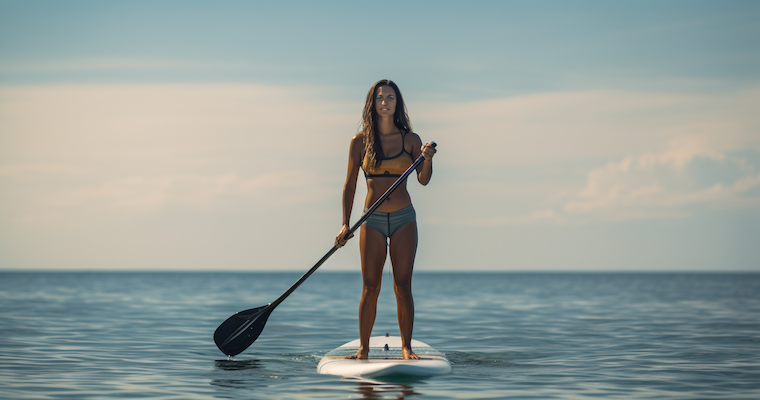Stand Up Paddleboarding (SUP) is an exhilarating water sport that has been sweeping across the globe due to its myriad of benefits and the unique experiences it offers. It’s a versatile activity that not only provides a solid full-body workout but also offers a unique vantage point to enjoy the serene or sometimes wild nature of water bodies.
- Key Takeaways
- Getting Started with SUP
- Basic SUP Paddling Techniques
- Advanced SUP Paddling Techniques
- Common Mistakes and How to Avoid Them
- Frequently Asked Questions
- LSI and NLP Keywords
- Additional Resources
The flexibility of SUP makes it accessible to a broad spectrum of water enthusiasts, whether they are into recreational paddling, touring, racing, or even SUP yoga. The enticing world of SUP is inviting, and with the right guidance, anyone can partake in this enjoyable water sport.
Key Takeaways
- SUP is a full-body workout and provides a unique vantage point on water.
- It’s a versatile sport with various disciplines including recreational paddling, surfing, touring, racing, and SUP yoga.
- Getting the right gear and mastering basic paddling techniques are crucial for a good SUP experience.
Getting Started with SUP
Embarking on your SUP journey requires a bit of preparation. The primary step is getting the right gear which primarily includes a paddleboard, a paddle, and a Personal Flotation Device (PFD).
| Equipment | Description |
|---|---|
| Paddleboard | Your choice of board is determined by a mix of your weight, skill level, and the specific SUP activities you are interested in. |
| Paddle | A SUP paddle’s correct length reaches up to your wrist when you stand the paddle up in front of you and raise your arm above your head. |
| Personal Flotation Device (PFD) | Mandatory when paddling outside a surf or swimming area as per the U.S. Coast Guard regulations. |
Basic SUP Paddling Techniques
Mastering basic SUP paddling techniques is pivotal to enjoy your time on the water and ensure your safety.
- Proper Hand Positioning: Your lower hand should grip the paddle shaft while the upper hand should be on the top of the grip.
- Paddle Blade Orientation: The blade should be oriented with the angle facing away from you.
- Basic Paddle Strokes:
- Forward Stroke
- Sweep Stroke
- Reverse Stroke
Understanding Basic Paddling Techniques
Advanced SUP Paddling Techniques
As you grow comfortable with the basics, delving into advanced SUP paddling techniques will unlock new horizons for you on the water.
| Advanced Strokes | Description |
|---|---|
| Draw Stroke | Helps in moving sideways. |
| Cross Bow Stroke | Useful for sharper turns. |
Common Mistakes and How to Avoid Them
| Common Mistakes | Solutions |
|---|---|
| Incorrect Paddle Holding | Ensure the blade angles forward towards the direction you’re moving. |
| Poor Balance | Keep your weight centered over the board with a slight bend in your knees. |
Frequently Asked Questions
| Question | Answer |
|---|---|
| What is the ideal paddleboard size for a beginner? | A wider, longer board with more volume is often recommended for stability. |
| How do I maintain balance on a SUP? | Keep your weight centered over the board, maintain a slight bend in your knees. |
| What are the essential gear items for SUP? | Paddleboard, paddle, and a Personal Flotation Device (PFD). |
| How do I choose the right paddle for SUP? | The paddle’s correct length reaches up to your wrist when you stand it up in front of you and raise your arm above your head. |
Additional Resources
- Online Tutorials:
- Community Forums:
- Engage with other SUP enthusiasts on Stand Up Zone or Reddit’s SUP community.
- Local SUP Clubs and Events:
- Find local clubs or events to meet other SUP enthusiasts and gain hands-on experience.
